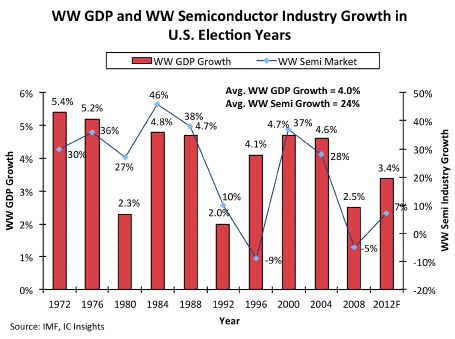Double-digit semiconductor growth in 8 of 10 past U.S. Presidential election years
March 06, 2012 -- Over the past several years, the world has witnessed bloviating U.S. political leaders butting heads and verbally sparring with each other. Just when you begin to believe that pontificating representatives are unable to work together to resolve differences on significant issues, along comes an election year and it seems "leaders" put aside many of their differences. The year 2012 is an election year for the U.S. president and numerous Congressmen and women. Historically, U.S. presidential election years have been very good for the semiconductor market as many elected officials attempt to pass (mostly short-term) legislation to boost the economy in order to look good in the eyes of voters and stand a better chance of getting re-elected.
Figure 1 shows that over the past 10 U.S. election years dating back to 1972, worldwide GDP growth averaged 4.0% while semiconductor industry growth has averaged 24%! In fact, the semiconductor industry has increased 10% or better in 8 of the past 10 U.S. election years. The two election years when the semiconductor industry did not grow 10% or better (1996 and 2008), it registered single-digit declines. For 2012, IC Insights is forecasting 3.4% WW GDP growth and single-digit (7%) semiconductor market growth.

Figure 1
The election-year uptick is one of the reasons IC Insights has identified 2013 as a possible slow year in the semiconductor industry. Over the past 10 post-U.S.-election years, worldwide GDP growth averaged 3.1% while worldwide semiconductor industry growth averaged only 4%. Moreover, worldwide semiconductor industry growth exceeded 8% in only three of these 10 post-election years (1973, 1977, and 1993).
Oftentimes the problem with post-election years is that many of the subsidies and stimulus measures enacted during an election year are withdrawn or allowed to expire after the election is over. For example, in the U.S., payroll tax cuts and unemployment benefits were extended through the end of 2012 (through the elections), but IC Insights does not expect these measures to be in place in the post-election year of 2013. Because of this, the U.S. economy is forecast to lose some momentum in 2013 before picking up speed again in 2014. It is worth noting that presidential elections will also be held in Russia, South Korea, Taiwan, China, and France this year, giving politicians in these countries additional incentive to boost their economies in 2012.
Report Source
The McClean Report 2012
More Information Contact
Bill McClean, president of IC Insights, phone: +1-480-348-1133, e-mail: bill@icinsights.com